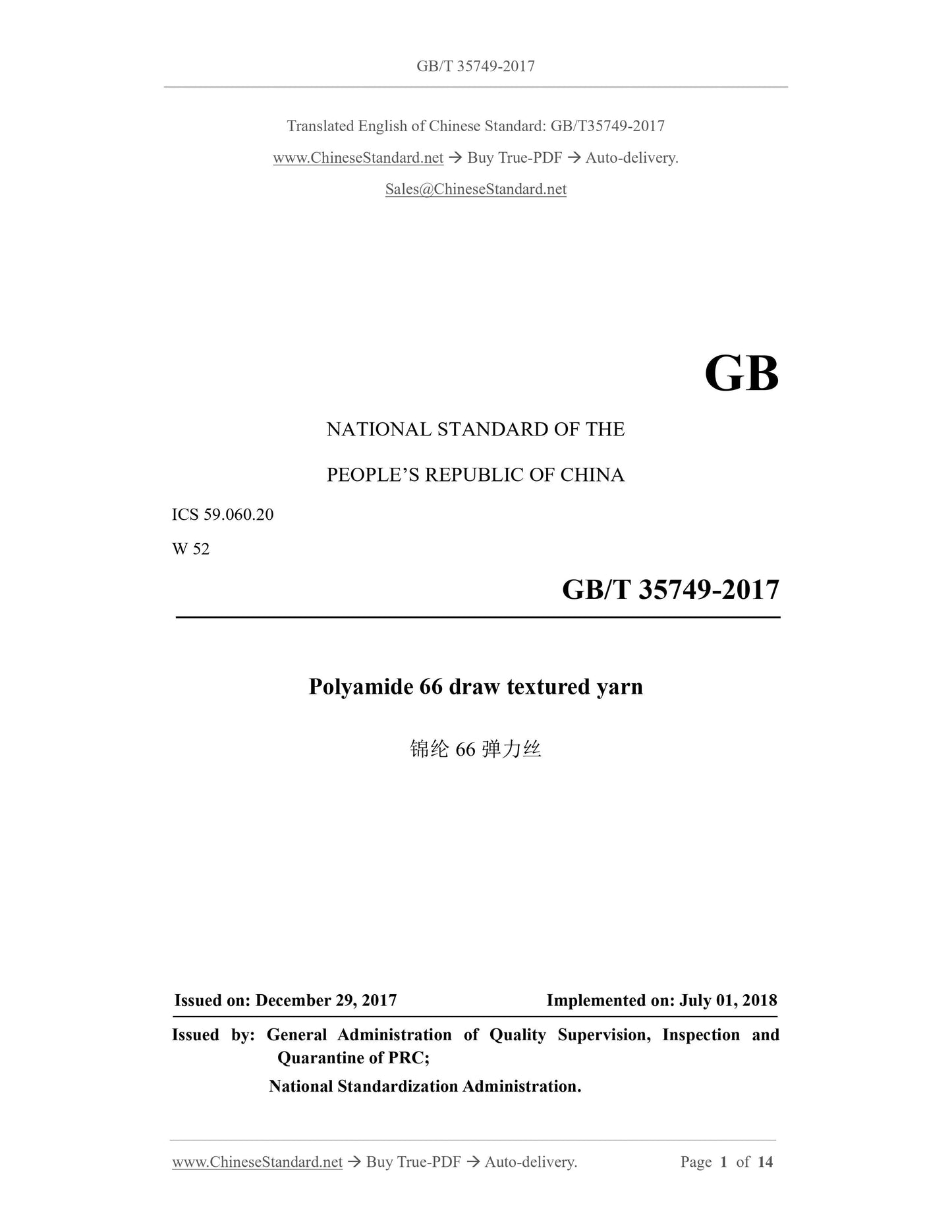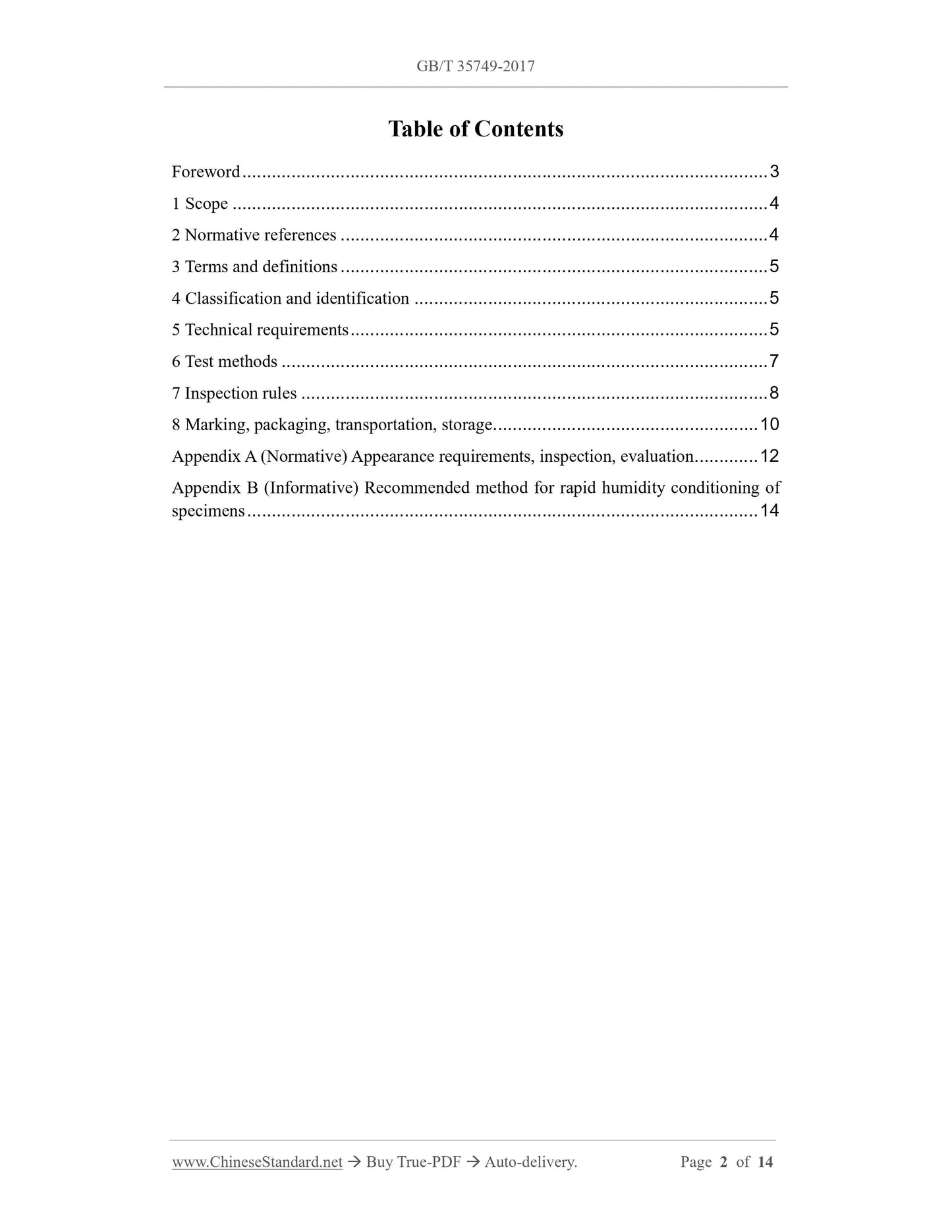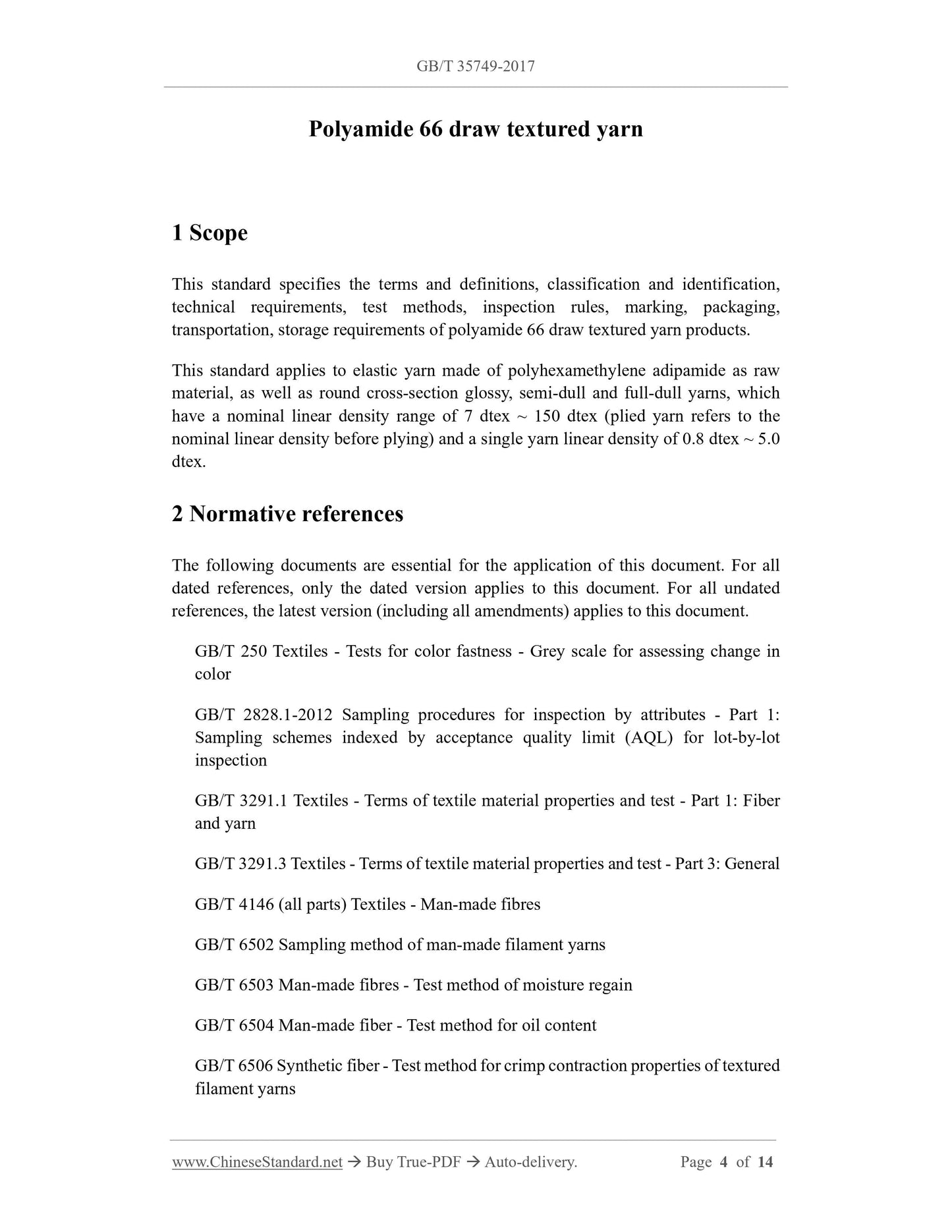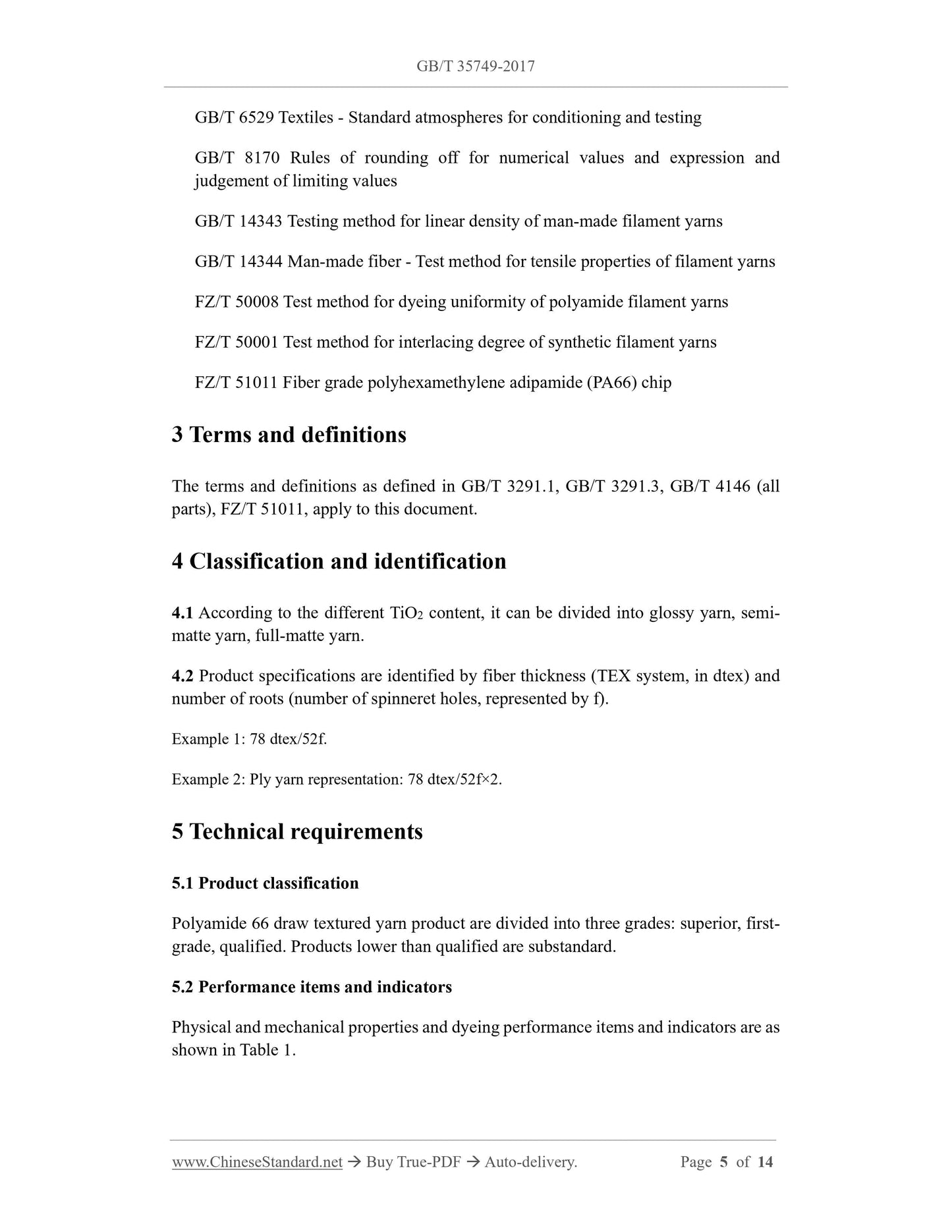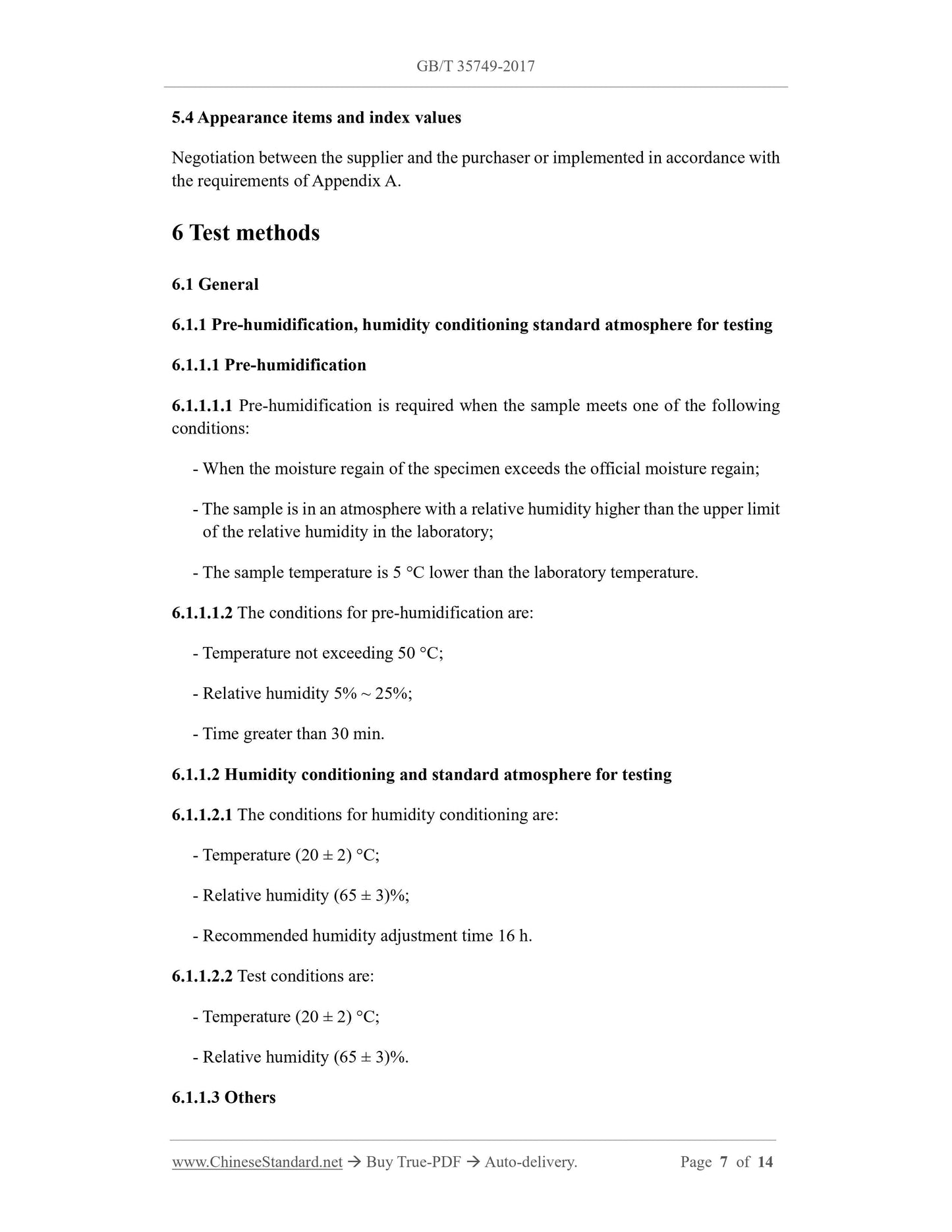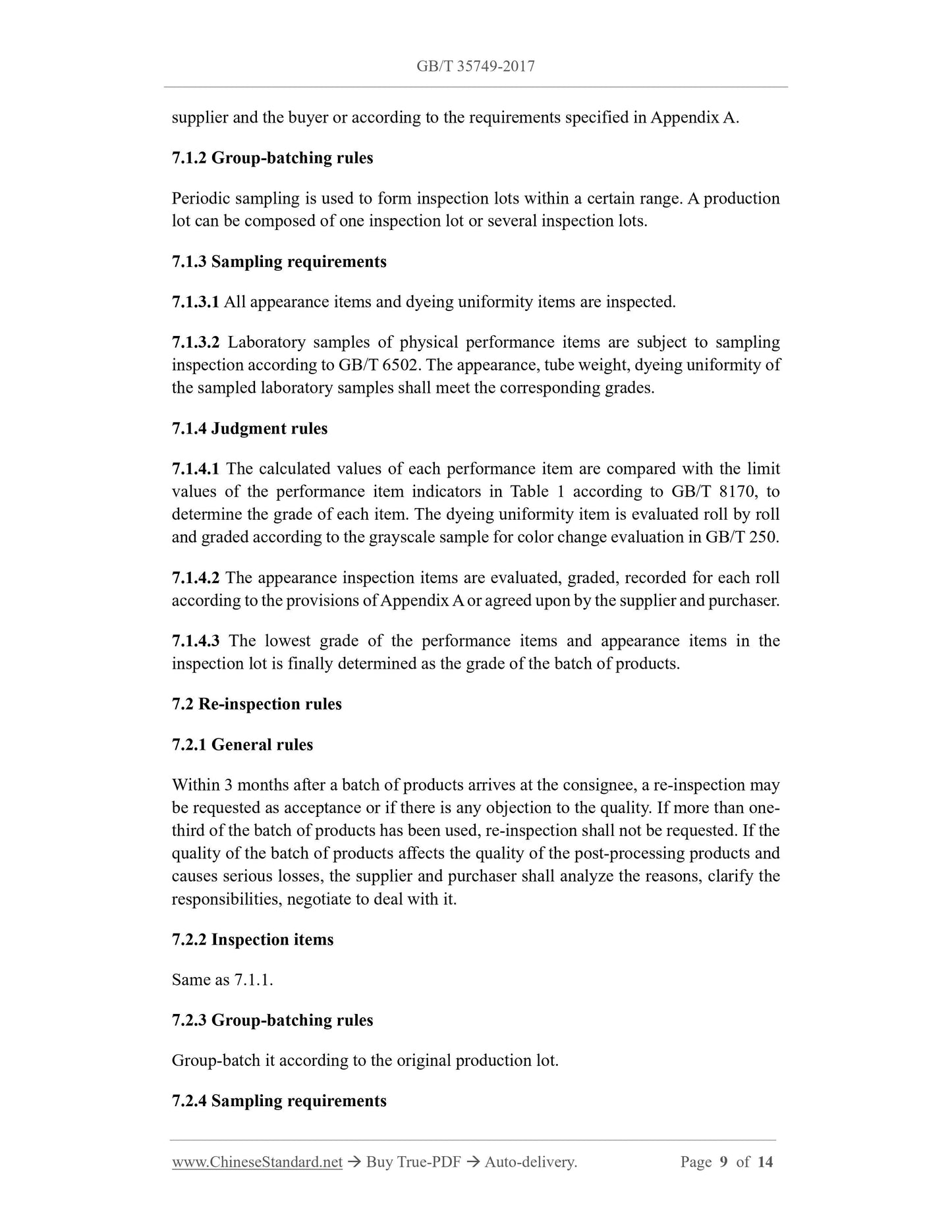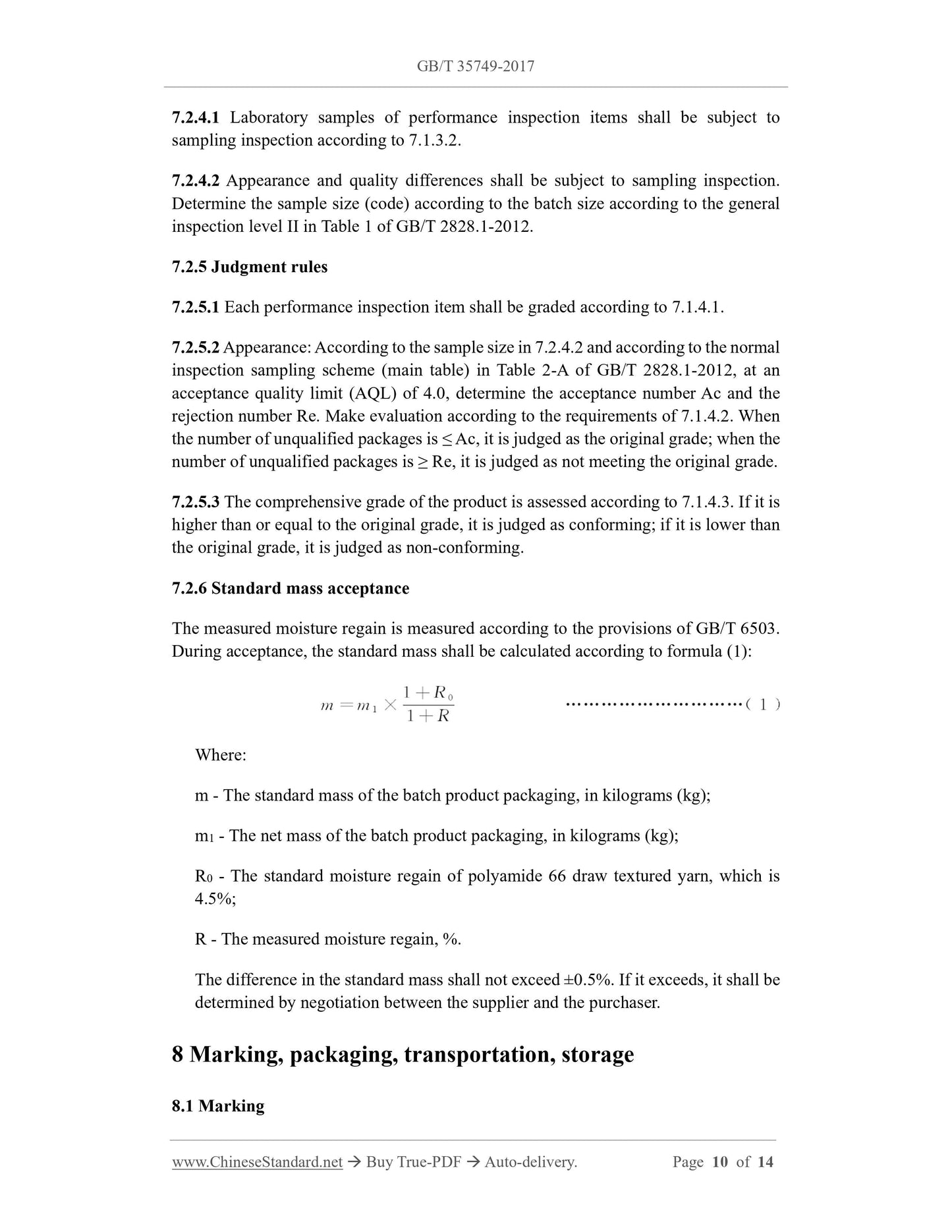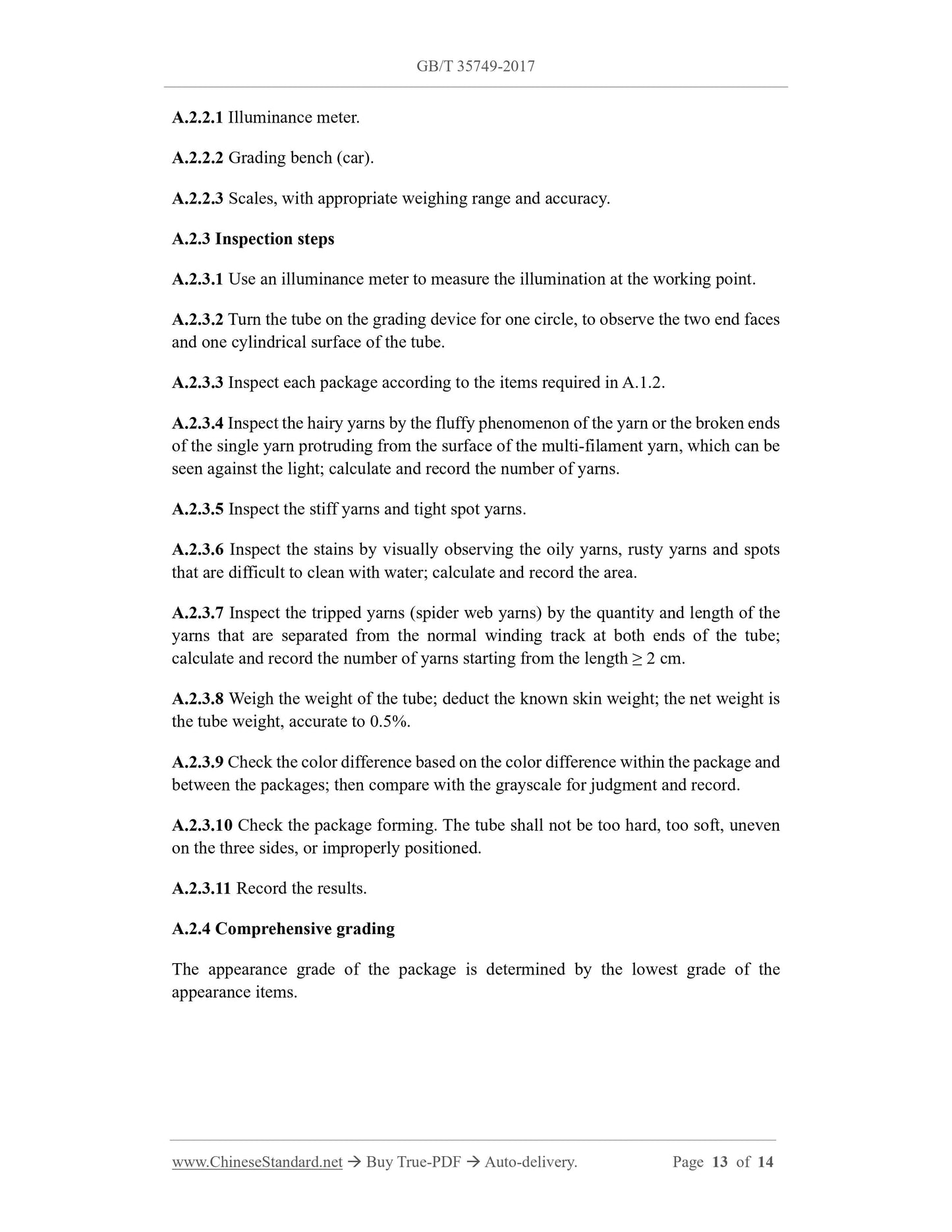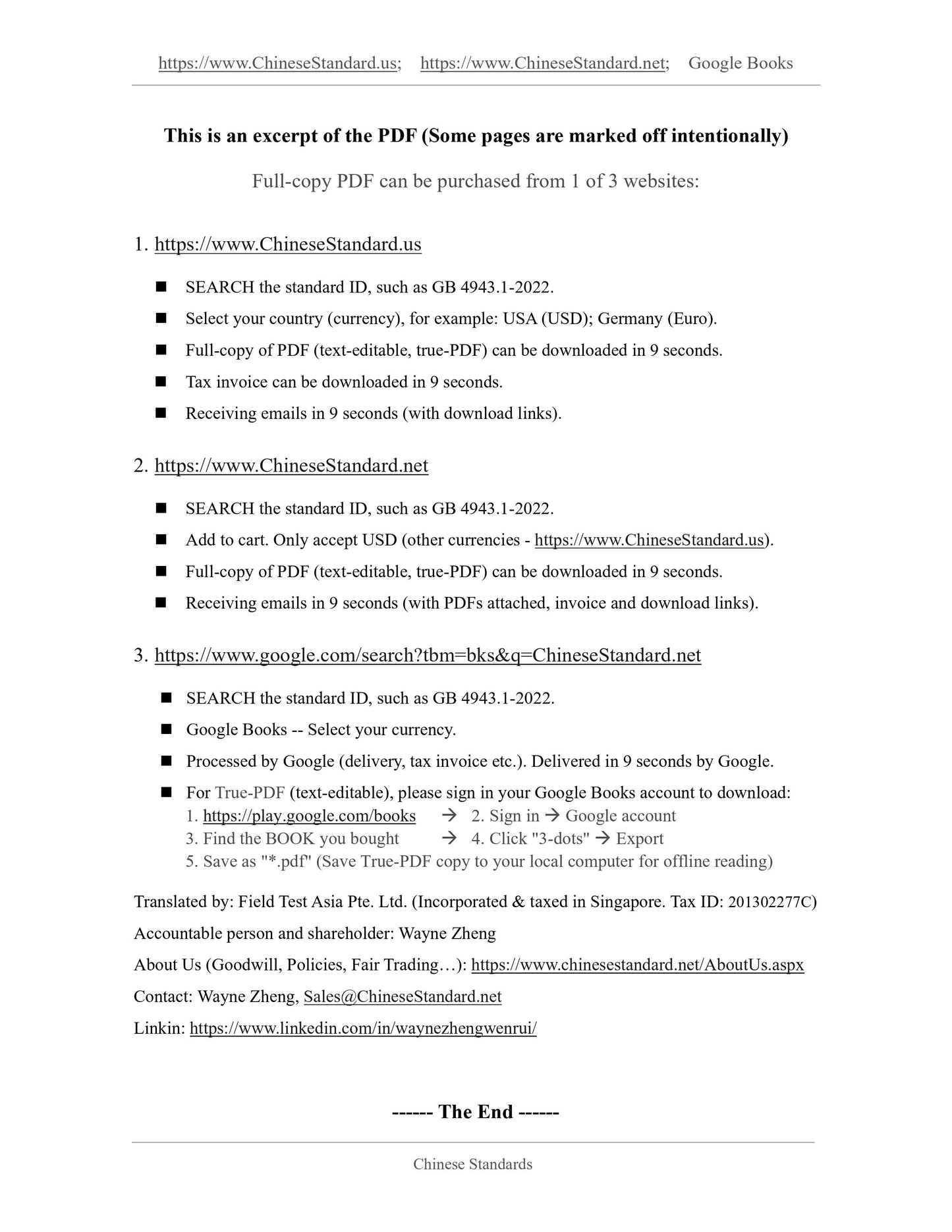1
/
of
9
PayPal, credit cards. Download editable-PDF and invoice in 1 second!
GB/T 35749-2017 English PDF (GBT35749-2017)
GB/T 35749-2017 English PDF (GBT35749-2017)
Regular price
$230.00 USD
Regular price
Sale price
$230.00 USD
Unit price
/
per
Shipping calculated at checkout.
Couldn't load pickup availability
Delivery: 3 seconds. Download true-PDF + Invoice.
Get QUOTATION in 1-minute: Click GB/T 35749-2017
Historical versions: GB/T 35749-2017
Preview True-PDF (Reload/Scroll if blank)
GB/T 35749-2017: Polyamide 66 draw textured yarn
GB/T 35749-2017
GB
NATIONAL STANDARD OF THE
PEOPLE’S REPUBLIC OF CHINA
ICS 59.060.20
W 52
Polyamide 66 draw textured yarn
锦纶 66弹力丝
ISSUED ON. DECEMBER 29, 2017
IMPLEMENTED ON. JULY 01, 2018
Issued by. General Administration of Quality Supervision, Inspection and
Quarantine of PRC;
National Standardization Administration.
Table of Contents
Foreword... 3
1 Scope... 4
2 Normative references... 4
3 Terms and definitions... 5
4 Classification and identification... 5
5 Technical requirements... 5
6 Test methods... 7
7 Inspection rules... 8
8 Marking, packaging, transportation, storage... 10
Appendix A (Normative) Appearance requirements, inspection, evaluation... 12
Appendix B (Informative) Recommended method for rapid humidity conditioning of
specimens... 14
Polyamide 66 draw textured yarn
1 Scope
This standard specifies the terms and definitions, classification and identification,
technical requirements, test methods, inspection rules, marking, packaging,
transportation, storage requirements of polyamide 66 draw textured yarn products.
This standard applies to elastic yarn made of polyhexamethylene adipamide as raw
material, as well as round cross-section glossy, semi-dull and full-dull yarns, which
have a nominal linear density range of 7 dtex ~ 150 dtex (plied yarn refers to the
nominal linear density before plying) and a single yarn linear density of 0.8 dtex ~ 5.0
dtex.
2 Normative references
The following documents are essential for the application of this document. For all
dated references, only the dated version applies to this document. For all undated
references, the latest version (including all amendments) applies to this document.
GB/T 250 Textiles - Tests for color fastness - Grey scale for assessing change in
color
GB/T 2828.1-2012 Sampling procedures for inspection by attributes - Part 1.
Sampling schemes indexed by acceptance quality limit (AQL) for lot-by-lot
inspection
GB/T 3291.1 Textiles - Terms of textile material properties and test - Part 1.Fiber
and yarn
GB/T 3291.3 Textiles - Terms of textile material properties and test - Part 3.General
GB/T 4146 (all parts) Textiles - Man-made fibres
GB/T 6502 Sampling method of man-made filament yarns
GB/T 6503 Man-made fibres - Test method of moisture regain
GB/T 6504 Man-made fiber - Test method for oil content
GB/T 6506 Synthetic fiber - Test method for crimp contraction properties of textured
filament yarns
GB/T 6529 Textiles - Standard atmospheres for conditioning and testing
GB/T 8170 Rules of rounding off for numerical values and expression and
judgement of limiting values
GB/T 14343 Testing method for linear density of man-made filament yarns
GB/T 14344 Man-made fiber - Test method for tensile properties of filament yarns
FZ/T 50008 Test method for dyeing uniformity of polyamide filament yarns
FZ/T 50001 Test method for interlacing degree of synthetic filament yarns
FZ/T 51011 Fiber grade polyhexamethylene adipamide (PA66) chip
3 Terms and definitions
The terms and definitions as defined in GB/T 3291.1, GB/T 3291.3, GB/T 4146 (all
parts), FZ/T 51011, apply to this document.
4 Classification and identification
4.1 According to the different TiO2 content, it can be divided into glossy yarn, semi-
matte yarn, full-matte yarn.
4.2 Product specifications are identified by fiber thickness (TEX system, in dtex) and
number of roots (number of spinneret holes, represented by f).
Example 1.78 dtex/52f.
Example 2.Ply yarn representation. 78 dtex/52f×2.
5 Technical requirements
5.1 Product classification
Polyamide 66 draw textured yarn product are divided into three grades. superior, first-
grade, qualified. Products lower than qualified are substandard.
5.2 Performance items and indicators
Physical and mechanical properties and dyeing performance items and indicators are as
shown in Table 1.
5.4 Appearance items and index values
Negotiation between the supplier and the purchaser or implemented in accordance with
the requirements of Appendix A.
6 Test methods
6.1 General
6.1.1 Pre-humidification, humidity conditioning standard atmosphere for testing
6.1.1.1 Pre-humidification
6.1.1.1.1 Pre-humidification is required when the sample meets one of the following
conditions.
- When the moisture regain of the specimen exceeds the official moisture regain;
- The sample is in an atmosphere with a relative humidity higher than the upper limit
of the relative humidity in the laboratory;
- The sample temperature is 5 °C lower than the laboratory temperature.
6.1.1.1.2 The conditions for pre-humidification are.
- Temperature not exceeding 50 °C;
- Relative humidity 5% ~ 25%;
- Time greater than 30 min.
6.1.1.2 Humidity conditioning and standard atmosphere for testing
6.1.1.2.1 The conditions for humidity conditioning are.
- Temperature (20 ± 2) °C;
- Relative humidity (65 ± 3)%;
- Recommended humidity adjustment time 16 h.
6.1.1.2.2 Test conditions are.
- Temperature (20 ± 2) °C;
- Relative humidity (65 ± 3)%.
6.1.1.3 Others
supplier and the buyer or according to the requirements specified in Appendix A.
7.1.2 Group-batching rules
Periodic sampling is used to form inspection lots within a certain range. A production
lot can be composed of one inspection lot or several inspection lots.
7.1.3 Sampling requirements
7.1.3.1 All appearance items and dyeing uniformity items are inspected.
7.1.3.2 Laboratory samples of physical performance items are subject to sampling
inspection according to GB/T 6502.The appearance, tube weight, dyeing uniformity of
the sampled laboratory samples shall meet the corresponding grades.
7.1.4 Judgment rules
7.1.4.1 The calculated values of each performance item are compared with the limit
values of the performance item indicators in Table 1 according to GB/T 8170, to
determine the grade of each item. The dyeing uniformity item is evaluated roll by roll
and graded according to the grayscale sample for color change evaluation in GB/T 250.
7.1.4.2 The appearance inspection items are evaluated, graded, recorded for each roll
according to the provisions of Appendix A or agreed upon by the supplier and purchaser.
7.1.4.3 The lowest grade of the performance items and appearance items in the
inspection lot is finally determined as the grade of the batch of products.
7.2 Re-inspection rules
7.2.1 General rules
Within 3 months after a batch of products arrives at the consignee, a re-inspection may
be requested as acceptance or if there is any objection to the quality. If more than one-
third of the batch of products has been used, re-inspection shall not be requested. If the
quality of the batch of products affects the quality of the post-processing products and
causes serious losses, the supplier and purchaser shall analyze the reasons, clarify the
responsibilities, negotiate to deal with it.
7.2.2 Inspection items
Same as 7.1.1.
7.2.3 Group-batching rules
Group-batch it according to the original production lot.
7.2.4 Sampling requirements
7.2.4.1 Laboratory samples of performance inspection items shall be subject to
sampling inspection according to 7.1.3.2.
7.2.4.2 Appearance and quality differences shall be subject to sampling inspection.
Determine the sample size (code) according to the batch size according to the general
inspection level II in Table 1 of GB/T 2828.1-2012.
7.2.5 Judgment rules
Get QUOTATION in 1-minute: Click GB/T 35749-2017
Historical versions: GB/T 35749-2017
Preview True-PDF (Reload/Scroll if blank)
GB/T 35749-2017: Polyamide 66 draw textured yarn
GB/T 35749-2017
GB
NATIONAL STANDARD OF THE
PEOPLE’S REPUBLIC OF CHINA
ICS 59.060.20
W 52
Polyamide 66 draw textured yarn
锦纶 66弹力丝
ISSUED ON. DECEMBER 29, 2017
IMPLEMENTED ON. JULY 01, 2018
Issued by. General Administration of Quality Supervision, Inspection and
Quarantine of PRC;
National Standardization Administration.
Table of Contents
Foreword... 3
1 Scope... 4
2 Normative references... 4
3 Terms and definitions... 5
4 Classification and identification... 5
5 Technical requirements... 5
6 Test methods... 7
7 Inspection rules... 8
8 Marking, packaging, transportation, storage... 10
Appendix A (Normative) Appearance requirements, inspection, evaluation... 12
Appendix B (Informative) Recommended method for rapid humidity conditioning of
specimens... 14
Polyamide 66 draw textured yarn
1 Scope
This standard specifies the terms and definitions, classification and identification,
technical requirements, test methods, inspection rules, marking, packaging,
transportation, storage requirements of polyamide 66 draw textured yarn products.
This standard applies to elastic yarn made of polyhexamethylene adipamide as raw
material, as well as round cross-section glossy, semi-dull and full-dull yarns, which
have a nominal linear density range of 7 dtex ~ 150 dtex (plied yarn refers to the
nominal linear density before plying) and a single yarn linear density of 0.8 dtex ~ 5.0
dtex.
2 Normative references
The following documents are essential for the application of this document. For all
dated references, only the dated version applies to this document. For all undated
references, the latest version (including all amendments) applies to this document.
GB/T 250 Textiles - Tests for color fastness - Grey scale for assessing change in
color
GB/T 2828.1-2012 Sampling procedures for inspection by attributes - Part 1.
Sampling schemes indexed by acceptance quality limit (AQL) for lot-by-lot
inspection
GB/T 3291.1 Textiles - Terms of textile material properties and test - Part 1.Fiber
and yarn
GB/T 3291.3 Textiles - Terms of textile material properties and test - Part 3.General
GB/T 4146 (all parts) Textiles - Man-made fibres
GB/T 6502 Sampling method of man-made filament yarns
GB/T 6503 Man-made fibres - Test method of moisture regain
GB/T 6504 Man-made fiber - Test method for oil content
GB/T 6506 Synthetic fiber - Test method for crimp contraction properties of textured
filament yarns
GB/T 6529 Textiles - Standard atmospheres for conditioning and testing
GB/T 8170 Rules of rounding off for numerical values and expression and
judgement of limiting values
GB/T 14343 Testing method for linear density of man-made filament yarns
GB/T 14344 Man-made fiber - Test method for tensile properties of filament yarns
FZ/T 50008 Test method for dyeing uniformity of polyamide filament yarns
FZ/T 50001 Test method for interlacing degree of synthetic filament yarns
FZ/T 51011 Fiber grade polyhexamethylene adipamide (PA66) chip
3 Terms and definitions
The terms and definitions as defined in GB/T 3291.1, GB/T 3291.3, GB/T 4146 (all
parts), FZ/T 51011, apply to this document.
4 Classification and identification
4.1 According to the different TiO2 content, it can be divided into glossy yarn, semi-
matte yarn, full-matte yarn.
4.2 Product specifications are identified by fiber thickness (TEX system, in dtex) and
number of roots (number of spinneret holes, represented by f).
Example 1.78 dtex/52f.
Example 2.Ply yarn representation. 78 dtex/52f×2.
5 Technical requirements
5.1 Product classification
Polyamide 66 draw textured yarn product are divided into three grades. superior, first-
grade, qualified. Products lower than qualified are substandard.
5.2 Performance items and indicators
Physical and mechanical properties and dyeing performance items and indicators are as
shown in Table 1.
5.4 Appearance items and index values
Negotiation between the supplier and the purchaser or implemented in accordance with
the requirements of Appendix A.
6 Test methods
6.1 General
6.1.1 Pre-humidification, humidity conditioning standard atmosphere for testing
6.1.1.1 Pre-humidification
6.1.1.1.1 Pre-humidification is required when the sample meets one of the following
conditions.
- When the moisture regain of the specimen exceeds the official moisture regain;
- The sample is in an atmosphere with a relative humidity higher than the upper limit
of the relative humidity in the laboratory;
- The sample temperature is 5 °C lower than the laboratory temperature.
6.1.1.1.2 The conditions for pre-humidification are.
- Temperature not exceeding 50 °C;
- Relative humidity 5% ~ 25%;
- Time greater than 30 min.
6.1.1.2 Humidity conditioning and standard atmosphere for testing
6.1.1.2.1 The conditions for humidity conditioning are.
- Temperature (20 ± 2) °C;
- Relative humidity (65 ± 3)%;
- Recommended humidity adjustment time 16 h.
6.1.1.2.2 Test conditions are.
- Temperature (20 ± 2) °C;
- Relative humidity (65 ± 3)%.
6.1.1.3 Others
supplier and the buyer or according to the requirements specified in Appendix A.
7.1.2 Group-batching rules
Periodic sampling is used to form inspection lots within a certain range. A production
lot can be composed of one inspection lot or several inspection lots.
7.1.3 Sampling requirements
7.1.3.1 All appearance items and dyeing uniformity items are inspected.
7.1.3.2 Laboratory samples of physical performance items are subject to sampling
inspection according to GB/T 6502.The appearance, tube weight, dyeing uniformity of
the sampled laboratory samples shall meet the corresponding grades.
7.1.4 Judgment rules
7.1.4.1 The calculated values of each performance item are compared with the limit
values of the performance item indicators in Table 1 according to GB/T 8170, to
determine the grade of each item. The dyeing uniformity item is evaluated roll by roll
and graded according to the grayscale sample for color change evaluation in GB/T 250.
7.1.4.2 The appearance inspection items are evaluated, graded, recorded for each roll
according to the provisions of Appendix A or agreed upon by the supplier and purchaser.
7.1.4.3 The lowest grade of the performance items and appearance items in the
inspection lot is finally determined as the grade of the batch of products.
7.2 Re-inspection rules
7.2.1 General rules
Within 3 months after a batch of products arrives at the consignee, a re-inspection may
be requested as acceptance or if there is any objection to the quality. If more than one-
third of the batch of products has been used, re-inspection shall not be requested. If the
quality of the batch of products affects the quality of the post-processing products and
causes serious losses, the supplier and purchaser shall analyze the reasons, clarify the
responsibilities, negotiate to deal with it.
7.2.2 Inspection items
Same as 7.1.1.
7.2.3 Group-batching rules
Group-batch it according to the original production lot.
7.2.4 Sampling requirements
7.2.4.1 Laboratory samples of performance inspection items shall be subject to
sampling inspection according to 7.1.3.2.
7.2.4.2 Appearance and quality differences shall be subject to sampling inspection.
Determine the sample size (code) according to the batch size according to the general
inspection level II in Table 1 of GB/T 2828.1-2012.
7.2.5 Judgment rules
Share
